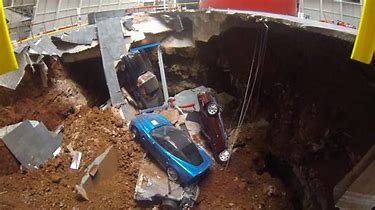I have received permission from the Park Manager to place this Earth Cache. However , he asks that NOONE descend into the holes or attempt to enter any opening you will find at the sinkholes coordinates.
This series of Sinks plays a part in the History of this park. Under Tom Sawyer park is a cave system that extends from West Port Road to near Oxmoor Farms ( Now Oxmoor Mall) It has been rumored that this cave system was used as part of the underground railroad.
I' ve lived near here for over 20 years and I have observed the change of GZ almost dailey.
But before we discuss GZ lets look at a couple of now famous Sinkholes in recent Kentucky history.
The first happened in March of 2019 at the Louisville Zoo. The landscape there , as here at GZ , is known as Karst, "It forms a big arc from Lexington to Bowling Green", said Thomas Brackman, who directs the Geophysics Laboratory at Western Kentucky University. The sinkhole at the zoo opened to 60 yards wide, 90 yards long and 50 feet deep.It has been suggested that possible causes include rain runoff or "natural occurrences" underground.

The second and possibly the most well-known took place in February of 2014 at the National Corvette museum. This sinkhole opened up to 40 ft. across and up to 30 ft. deep . This hole became infamous for having Eight Corvettes on display at the Museum plummet into the cavern that was created.
Now that we have read how destructive these natural forming holes can be lets get back to the sink hole(s) at Tom Sawyer park. There are a series of sinkholes that can be followed from near West Port road to near the creek at the park but for our experience we will walk the path from GZ to two more nearby holes and study their similarities and possible differences.
As mentioned earlier the underling landscape is "karst". This type terrain often develops atop limestone – and more than 50 percent of Kentucky’s surface rocks are limestone, which explains the state’s abundant karst environment.Karst environments are typically characterized by the existence of sinkholes. Sinkholes often form in three ways. The most publicized type is a cover-collapse sinkhole, which occurs when the roof of a cave becomes too thin to support the weight of the bed rock and soil above it and therefore collapses. This type scenario often causes catastrophic damage. However, not all sinkholes are this spectacular in their developement. There are also cover-subsidence sinkholes, which slowly develop and form sunken depressions as the ground under them deflates due to dissolving bedrock and Solution Sinkholes which occur where exposed Limestone is present.
. Historically, the number of collapses is smallest in February, steadily increases to peak in July, and then decreases through December and into January.
COVER COLLAPSE SINKHOLE:Cover-collapse sinkholes may develop abruptly (over a period of hours) and thus cause catastrophic damages. They occur where the covering sediments contain a significant amount of clay. Over time, surface drainage, erosion, and deposition of sinkhole into a shallower bowl-shaped depression. 
COVER SUBSIDENCE SINKHOLE: Cover-subsidence sinkholes tend to develop gradually where the covering sediments are permeable and contain sand. In areas where cover material is thicker or sediments contain more clay, cover-subsidence sinkholes are relatively uncommon and therefore may not be seen frequently. They are smaller and thus may go undetected for long periods.

SOLUTION SINKHOLES:Solution sinkholes occur in areas where limestone is exposed at land surface or also is covered by thin layers of soil and permeable sand. Dissolution of the limestone or dolomite is most intensive where the water first contacts the rock surface. Aggressive dissolution also occurs where flow is focused in preexisting openings in the rock, such as along joints, fractures, and bedding planes, and in the zone of water-table fluctuation where groundwater is in contact with the atmosphere. Solution sinkholes are generally small in size and also slow to develop.

Weather : Precipitation has long been thought to influence the timing and rate of cover collapse (Tharp, 1999). In fields and woodlands, where recharge is slowed and initially more evenly distributed by the canopy, grassland, or vegetative litter on the forest floor, the areal distribution of collapse is seemingly random. Closely spaced clusters in Georgia were associated with riverine flooding, however (described by Hyatt and Jacobs [1996]). Manmade structures, such as parking lots, can accentuate the collection of runoff, and are recognized as a frequent cause of collapse in urbanized areas. Case histories describing seemingly inconsequential water sources, such as downspout discharge, onsite sewage disposal, and air-conditioner condensate, also occur in the data set. The wetter months, therefore, have been assumed to have more frequent incidences of cover collapse (White and White, 1992).
AS we walk from GZ to Sinkhole # 2 and then Sinkhole #3 lets look at the similarities and then submit your answers to me via the message system in place form Geocaching.com.
1) After walking to all three sinkholes, which type of sinkholes do you think are present?
2) Which is the largest? 1,2,or 3?
3) Briefly describe the differences between the three types of sinkholes discussed in the write-up above?
4) AT sinkhole #3 what do you immediately notice that is different from the other two?
5) At each location, what do you notice as being the parks " remedy" for closing the openings
6) Now head North , cross the road and follow that direction ,locate a 4th sinkhole ( PLEASE BE CAREFUL CROSSING THE ROAD). Plot those coordinates.
7) Briefly describe what you find. What makes it similar to GZ (Sinkhole #1)?
8) In your opinion, do the weather shifts in this region contribute to the number of sinkholes in this particular area.
9) Which month of the year do you you think has the most sinkhole occurrences? (hint: its in the reading)
10) Not a requirement, but would be appreciated, feel free to post a picture of yourself with or without your GPS at your sinkhole of choice.
